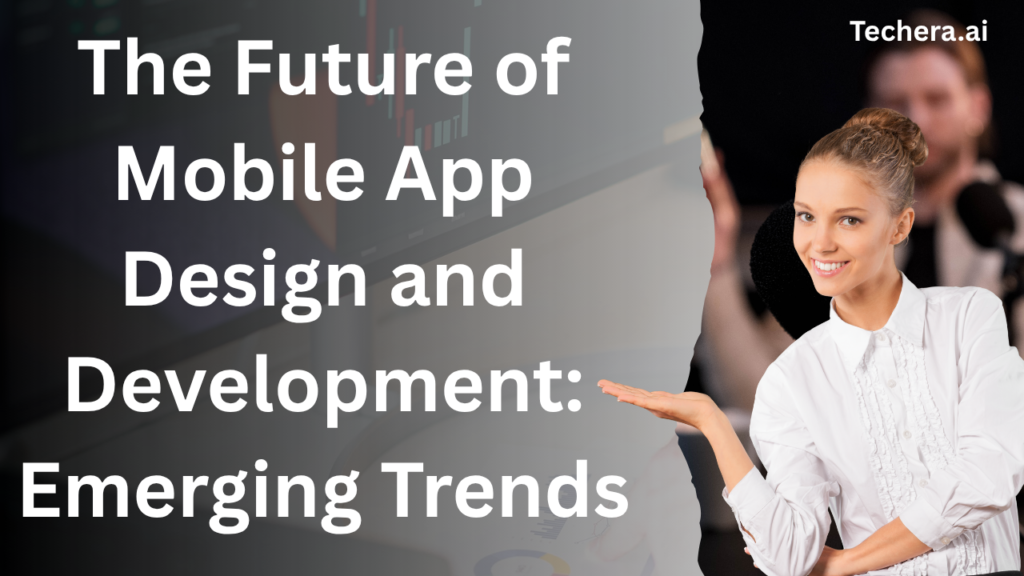
Explore the latest innovations shaping the future of mobile app design and development. This post highlights emerging trends, cutting-edge technologies, and creative strategies that are transforming how modern apps are designed and built for next-generation users.
Introduction
The world of mobile apps has evolved from simple tools to complex, intelligent ecosystems. As technology continues to advance, so do user expectations. Developers and designers who adapt quickly to emerging trends are the ones shaping the digital future. Let’s explore what lies ahead in mobile app design and development—and how you can stay ahead of the curve.
The Rapid Growth of Mobile Technology
Mobile app design and development have come a long way since the first smartphones hit the market. Today, they’re not just utilities—they’re extensions of our daily lives.
From Simple to Smart
Apps now use AI, cloud services, and IoT to deliver seamless experiences. Think of how Netflix recommends shows or how your smartwatch tracks your fitness—it’s all part of a larger intelligent network.
Impact of 5G
The rollout of 5G is revolutionizing app performance. Faster speeds and lower latency allow real-time gaming, smoother video streaming, and instant data transfers.
AI and Machine Learning in App Development
AI isn’t the future—it’s already here.
Personalized Experiences
Apps now “learn” from users. For example, Spotify curates playlists based on listening habits, and eCommerce apps tailor recommendations for each shopper.
Predictive Analytics
Machine learning enables apps to anticipate user needs—like suggesting a route in a navigation app before you even open it.
Augmented Reality (AR) and Virtual Reality (VR
AR and VR are reshaping how users interact with digital content.
Immersive Experiences
From IKEA’s AR furniture app to VR-based learning platforms, these technologies are transforming industries from retail to education.
Tools to Explore
Developers can use ARKit, ARCore, and Unity to create engaging AR/VR experiences that blur the line between the virtual and real worlds.
The Rise of Voice-Enabled Apps
Voice technology is quickly becoming mainstream, thanks to Siri, Alexa, and Google Assistant.
Voice as a Primary Interface
Users now prefer hands-free experiences. Apps integrated with voice commands improve accessibility and user engagement.
Designing for Voice
Voice-first design means focusing on conversational interfaces, natural language processing, and minimal visual clutter.
Also Read Mobile App Design and Development: Essential Tips for Beginner Developers
The Future of Cross-Platform Development
Code Once, Deploy Everywhere
Frameworks like Flutter and React Native allow developers to build apps for iOS and Android simultaneously, saving time and cost.
Beyond the Basics
Future tools may enable universal app experiences across phones, tablets, wearables, and even smart TVs.
Progressive Web Apps (PWAs): The Hybrid Future
PWAs blend the best of web and mobile.
Why PWAs Matter
They’re lightweight, fast, and don’t require installation. For businesses, they offer better reach without app store restrictions.
Advantages
Instant updates, offline functionality, and lower Mobile app design and development costs make PWAs a powerful alternative.
Blockchain in Mobile App Development

Security Meets Transparency
Blockchain ensures data integrity and security, especially in financial and healthcare apps.
Rise of DApps
Decentralized apps are redefining privacy and user control—think cryptocurrency wallets and NFT marketplaces.
Internet of Things (IoT) Integration
Connecting Everything
From smart thermostats to connected cars, IoT apps link physical devices to the digital world.
Developer Opportunities
Building IoT-compatible apps involves real-time data synchronization and seamless device communication.
5G and Its Transformative Impact
5G technology will fuel innovation in mobile app capabilities.
Real-Time Power
Imagine multiplayer AR games with zero lag or instant video conferencing—5G makes this possible.
Rich Content Experiences
Higher bandwidth supports 4K video streaming, immersive graphics, and faster cloud access.
Focus on Security and Privacy

With great technology comes greater responsibility.
Why It Matters
Users are increasingly aware of data privacy. Apps must comply with GDPR, HIPAA, and similar regulations.
Best Practices
Use end-to-end encryption, secure APIs, and biometric authentication to safeguard data.
Minimalist and Adaptive UI Design
Design is becoming smarter, cleaner, and more adaptive.
Less Is More
Minimalism enhances usability. Clean interfaces help users focus on what truly matters.
Adaptive Design
Dark mode, responsive layouts, and accessibility features ensure inclusivity and comfort for all users.
Sustainability and Green App Development
The Need for Eco-Friendly Apps
Sustainability is more than a buzzword. Developers are now focusing on reducing battery drain and optimizing code for efficiency.
Eco-Conscious Practices
Using green hosting and minimizing data usage can lower an app’s carbon footprint.
Low-Code and No-Code Platforms
The Democratization of App Building
Tools like Adalo, Bubble, and Glide empower non-developers to create functional apps.
Pros and Cons
While these tools accelerate development, they can limit customization for complex projects.
The Role of Cloud Technology
Scalable and Reliable
Cloud computing allows seamless data storage, scalability, and backup—ideal for global applications.
Cloud-Based Backend
Solutions like Firebase and AWS Amplify simplify backend management for developers.
The Future Developer Skillset
Adapting to New Demands
Tomorrow’s developers need a mix of creativity, coding, and understanding of AI, AR, and UX principles.
Continuous Learning
Staying updated with evolving frameworks and technologies is key to long-term success.
Conclusion
The future of mobile app design and development is not just about coding—it’s about crafting intelligent, personalized, and sustainable digital experiences. With innovations like AI, AR, blockchain, and 5G, the possibilities are limitless. As a developer or designer, your ability to adapt and innovate will define your success in this ever-evolving landscape.
FAQs
1. What is the biggest trend in mobile app development right now?
AI and machine learning are currently leading the way, offering smarter and more personalized user experiences.
2. How will 5G impact mobile apps?
5G enables faster data transfer, lower latency, and richer multimedia experiences, transforming app performance.
3. Are Progressive Web Apps replacing native apps?
Not entirely, but PWAs are a cost-effective alternative for businesses seeking wide accessibility.
4. What role does sustainability play in app design?
Developers are focusing on energy-efficient coding and optimizing performance to reduce environmental impact.
5. How can beginners prepare for future app development trends?
Start learning tools like Flutter, React Native, and AI frameworks—and never stop experimenting.

